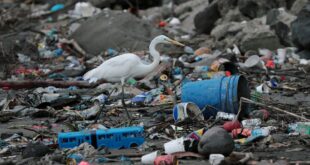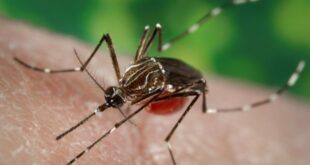Project combines satellite technology with near-simultaneous water sampling.

A team of experts is working to better understand the spread of blue-green algae in Alberta lakes by combining satellite technology with near-simultaneous water sampling.
The project, funded through Alberta Innovates, is a collaboration between several groups, including Alberta Lake Management Society (ALMS), the Alberta Biodiversity Monitoring Institute (ABMI), and researcher Rolf Vinebrooke from the University of Alberta.
Six Alberta lakes are being monitored for the project — Pigeon Lake, Sylvan Lake, Wabamun Lake, Nakamun Lake, Ethel Lake and Lac la Biche — though there is hope that the data can help create a model or algorithm that can be applied to other lakes.
When a satellite passes over the lake, water samples are collected at the same time to provide a clearer picture of the algae content.
Unlike previous methods of water sampling, which are not always processed in a timely manner, satellite imagery can help provide a better overall picture of what’s happening in a lake.
“Blue-green algal blooms can be very, very dynamic,” said Vinebrooke, a professor in the U of A’s department of biological sciences.
“They can be there one day and gone the next … satellite imagery data, once we’ve got a ground truth and the algorithms constructed, can provide near real-time estimates of how bad the blooms are on a variety of different lakes.”

Blue-green algae, or cyanobacteria, can form on slow-moving or stagnant water. The blooms can produce toxins that are harmful to humans, pets and wildlife. The growth of the algae can be driven by water rich in nitrogen and phosphorus.
There are currently dozens of cyanobacteria warnings issued by Alberta Health Services for lakes in the province.
The researchers believe the information they gather will be important for lake management associations to get a better understanding of what’s going on, and use that insight for phosphorus management programs to help reduce the blooms.
Vinebrooke said that once scientists have enough data, they can go back and compare the previous satellite images and have a more complete understanding of what the blooms in the lake and be able to track trends.
“There is a long-standing question, I think, in the minds of a lot of people in Alberta and across North America, and that is whether or not these harmful algal blooms are increasing in frequency,” he said. “Or is it just that they appear to be, because people are much more environmentally aware generally, as a public?
“This allows you to answer that question quantitatively.”
Clear picture
Fiona Gregory from ABMI said it’s been difficult for researchers to track trends due to a lack of continuous data.
Gregory is the lead of the earth observation analysis part of the project. She takes the results from the lake sampling program and compares them with the satellite imagery, working out what the relationship is and then applying the model to satellite imagery.
“At best the sampling is only like a snapshot in time,” Gregory said. “It can only be done, maybe several times a year, but with the satellite modelling, we hope to see what’s going on almost all the time throughout the season.”
Sentinel-2 satellite
While the initiative may seem straightforward, there are some logistical challenges.
The satellite used for the project doesn’t pass over Alberta every day, so researchers and volunteers have a relatively narrow window to capture the data.
“The satellite that we’re using is called the Sentinel-2 satellite, and this passes over about every five days,” said Bradley Peter, executive director of ALMS.
“And so we’re timing our sampling of the lake and that’s often with volunteers, partners who are driving the boat. We’re co-ordinating all of those schedules to be on the lake.”
Peter noted the sampling has to be done on a clear day, without too many clouds or smoke to muddle the images.
Eventually, the data will be available through an online mapping application. The public will be able to access the information for the six lakes, and possibly other lakes in Alberta, and get accurate information about the algae blooms.
The project uses Google Earth Engine, which allows the researchers to access and process large amounts of satellite imagery at scale.
The initiative comes after the success of a similar pilot project that started in 2019 that monitored Pigeon Lake, which has its data already available online. The map shows the concentration of chlorophyll-a, which is found in algae.
Warnings about algal blooms

AHS advises that people and pets should avoid all contact with water where a blue-green algae advisory is in place. Cyanobacteria can make people sick, and can be lethal to pets.
Those who come in contact or ingest blue-green algae can experience skin irritation, sore throat, swollen lips, fever, nausea, vomiting or diarrhea.
As of Aug. 25, AHS has advisories in place for the following lakes:
- Pigeon Lake.
- Haunted Lake.
- Wizard Lake.
- Alix Lake.
- Buck Lake.
- Moonshine Lake.
- Bonnie Lake.
- Winagami Lake.
- Crow Lake.
- Wabamun Lake.
- Matchayaw (Devil’s) Lake.
- Fork Lake.
- Garner Lake.
- Floatingstone Lake.
- Wapasu Lake.
- Goose Lake.
- Hastings Lake.
- Kehewin Lake.
- Elinor Lake.
- Reesor Lake.
- Nakamun Lake.
- Sturgeon Lake.
- Hutch Lake.
- Vermilion Lake.
- Stoney Lake.
- Eagle Lake.
- Square Lake.
- Lac Ste. Anne.
- Thunder Lake.
- Astotin Lake.
- Little Fish Lake.
- Severn Dam Reservoir.
- Lac la Biche.
- Isle Lake.
- Enchant Municipal Park.
- Lower Therien Lake.
- Gregoire Lake.
- Twin Valley Reservoir.
- Lessard Lake.
- Steele Lake.
- Skeleton Lake.
- Baptiste Lake.
- Pine Lake.
- Moose Lake.
- Muriel Lake.

Reporter/editor
Trevor Howlett is a journalist with CBC Edmonton. He previously reported in Nova Scotia, Fort McMurray and Red Deer. You can reach him at trevor.howlett@cbc.ca.
*****
Credit belongs to : www.cbc.ca
 Atin Ito First Filipino Community Newspaper in Ontario
Atin Ito First Filipino Community Newspaper in Ontario






